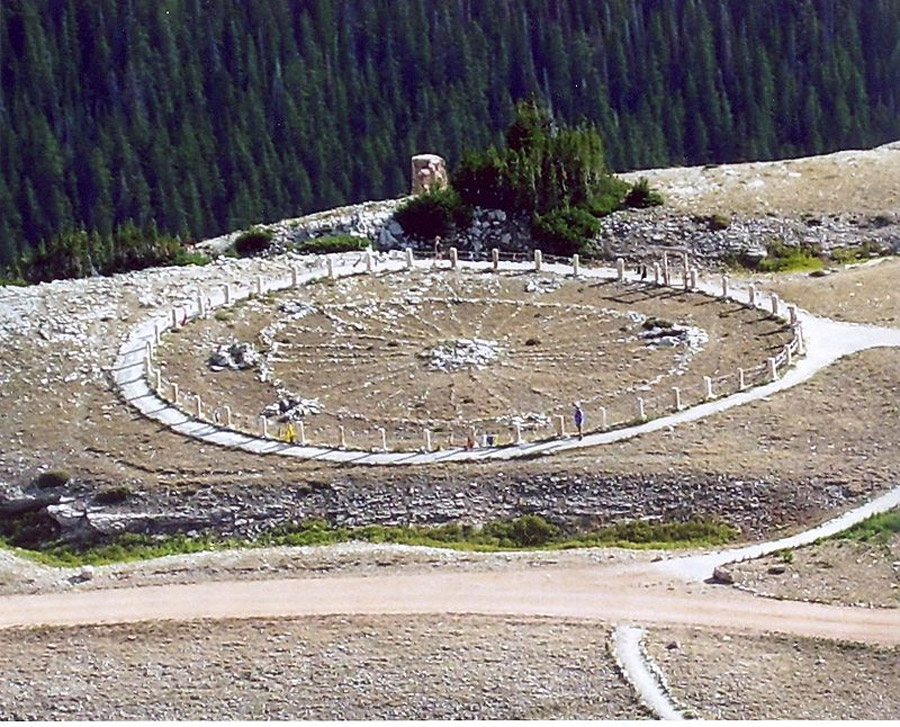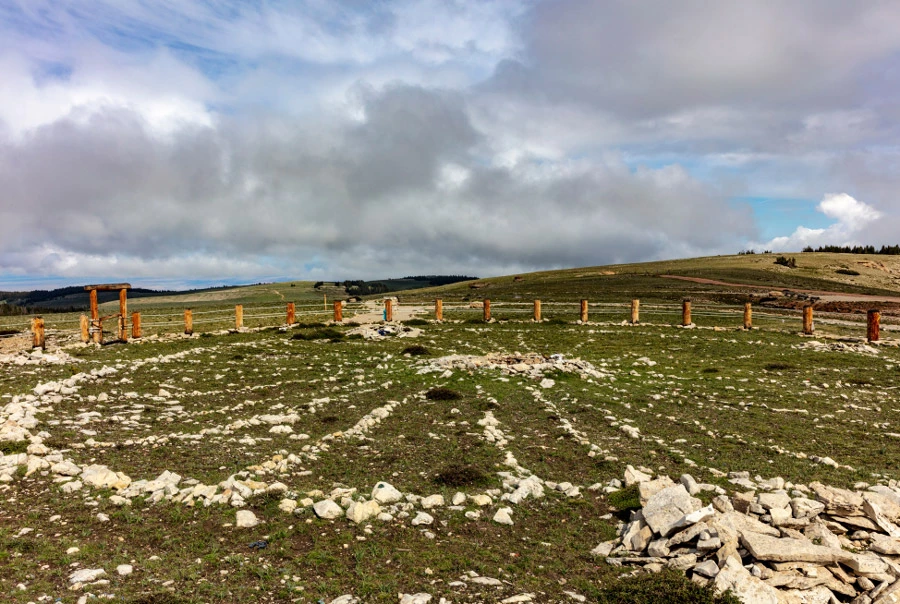The history of the modern United States is considered to be very recent. All of the formative events which made the modern superpower occurred within the last 300 years, first as a colony of the British Empire and then as a sovereign power.
However the history of that continent extends far further back in time, and contains much that is both highly sophisticated and poorly understood. Much of that early history is lost but some of the more enduring artifacts survive from the thousands of years before the west settled the great continent.
One such can be found in the Bighorn National Forest in the mountains of Wyoming, on a mountain named Medicine Mountain. This is the Bighorn Medicine Wheel, and it may be part of a cultural history that is 10,000 years old.
The Medicine Wheel is a huge stone structure made up of local white limestone. The stones are organized in such a way so as to form a wheel shape. The Wheel is nearly 80 feet (24 m) in diameter and consists of 28 spokes that radiate from a central cairn.
It contains a series of seven stone circles known as cairns. The cairn at the center of the Wheel is nearly 10 feet (3 m) in diameter. The other six are located near or at the rim and relatively smaller.
The surrounding landscape of the Bighorn Medicine Wheel contains a number of prehistoric and historic sites such as buried archaeological sites, tipi rings, and small chip-stone scatters. But this structure, hidden by snow for most of the year, was clearly something important.
Construction of the Medicine Wheel
The indigenous people in the area do not claim that they have constructed the Bighorn Medical Wheel. However, the Wheel is believed to have been built by Native Americans from the plains about 300 to 800 years ago. Since then, it has been used as well as maintained by a number of groups.
- Who Built the Bakoni Ruins of South Africa, and When?
- Cahokia Mounds: The Largest Ancient City in North America
The central cairn is known to be the oldest part of the Wheel, which is itself in turn a part of a larger complex of various interrelated archaeological sites. Near the Wheel, there are a number of ceremonial staging areas, sweat lodge sites, ceremonial and medicinal plant gathering areas, fasting enclosures, and altars.

This collection of archaeological, ethnographic, and ethnohistoric evidence, all in situ and presented as they were supposed to be, suggests that the Bighorn Medical Wheel and its surrounding areas are some of the most well preserved and important ancient Native American sites.
What Was It For?
The medicine wheels often have a spiritual meaning as well as an astronomical meaning. One of the popular uses of the medicine wheels is for marking geographical directions. They are also used for marking different astronomical events of the Moon, Sun, some planets, and some stars in relation to the horizon of the Earth.
The medicine wheels have also been used for a number of important ceremonies and teachings. It is even used as a sacred place for giving thanks to the Great Spirit, or the Creator.
The Bighorn Medicine Wheel is also believed to have been used for centuries by the local Native American Crow tribe’s youth for vision quest and fasting. Native Americans went to the Wheel in order to offer their prayers for healing. They even made atonement for any harm caused to others.
According to scientists and astronomers, the Bighorn Medical Wheel was also used as an ancient astronomical calendar and observatory by prehistoric Native Americans. The Bighorn Medicine Wheel is called “Hiieeinoonotii” by the Arapaho, who offer a distinct and detailed account relating to its ceremonial use.
- Temple, Spire or Alien Landing Pad? The Mystery of Somapura Mahavihara
- Who Made the Serpent Mound, the Largest Snake Geoglyph in the World?
Tom Yellowtail narrated the story of Burnt Face constructing a medical wheel in the Bighorn Mountains and later receiving help from the Little People, mysterious inhabitants of North America. After the Little People healed his face, Burnt Face returned from the Bighorns, joined his people, and constructed the Fort Smith Wheel. The Wheel is believed to have similar solar and stellar alignments to the Bighorn Medicine Wheel.
Astronomical Alignments
The Bighorn Medical Wheel is considered one of the four to five astronomically complex wheels in the Rocky Mountain region. The less complex and smaller medical wheels have certain astronomical significance like east-west orientations and solstice alignments.

The larger and more complex medicine wheels are however much more sophisticated, and can track the number of different cosmic styles such as the phases of the Moon, the precession of the equinoxes, solar and lunar eclipse cycles, and orbital cycles of the planets.
In 1974, Jack Eddy, an archaeo-astronomer, visited the Bighorn Medical Wheel to study its astronomical alignments. He carefully studied the alignment of the rocks, spokes, as well as cairns of the Bighorn Medical Wheel and made a number of significant discoveries.
Eddy found that the arrangement of the Medicine Wheel points to the rising as well as setting places of the Sun during the summer solstice. It also points to the rising places of Sirius in Canis Major, Aldebaran in Taurus, and Rigel in Orion, important and bright marker stars for the Solstice.
In the year 2011, the name of the site changed from the Bighorn Medicine Wheel to the Medicine Wheel/Medicine Mountain National Historic Landmark. Even today, the Wheel is used by a number of indigenous groups and remains an accurate predictor of the summer solstice.
There are a number of other medicine wheels that exists in the area. However, the Bighorn Medicine Wheel is the most well-preserved one, and the most important. Here we see the hidden history of North America, not as dead history but still being lived by the people who were here long before the west.
Top Image: The Bighorn Medicine Wheel has a tradition dating back 10,000 years. Source: Jozefklopacka / Adobe Stock.
By Bipin Dimri